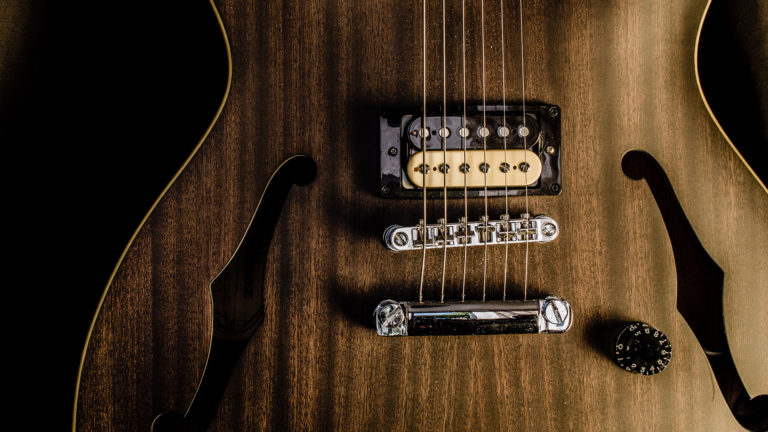Guitar River is reader-supported. We may earn a commission when you make a purchase using the links on our site.
Learn more.
How To Restring Your Electric Guitar In 8 Steps

Restringing or changing strings on an electric guitar is not difficult, but it will go much easier with a few tips. It’s also the perfect time to take care of a few maintenance tasks.
We’ll take a look at the process step by step, and alert you to some optional maintenance tips you can perform at the same time.
The first time you change the strings, it may take you a little while to get the hang of it. But after a few string changes, it will be second nature.
If you are wondering how often to change the strings, we will answer that question below. For now we’re going to assume that you are ready to change the strings. Let’s get started!
Recommended Tools
There are a few tools you will need to change your strings. You might have some of these on hand already. If not, these are easily purchased online or at your local music store. See our recommendations page for our picks. Here’s the list.
- Wire cutters – Just a basic pair of wire cutters will be fine. Nothing fancy.
- Needle nose pliers – These are optional, but can be helpful in removing the strings.
- New strings – Obviously, you’ll need a new set of strings to put on the guitar. We have some pointers on that below, but grab a set of extra light gauge (.009-.042) strings if in doubt.
- Guitar tuner – You likely already have a guitar tuner. You’ll need it to tune the strings to pitch. A basic headstock-mounted tuner will be fine.
- Fretboard conditioner – No, we’re not talking about hair. If you have a dark wood fretboard, it’s a good idea to use a special conditioner to keep it hydrated. Lemon oil is often used, but there is some debate about it. We recommend one of the commercially available products specifically designed for guitars.
- Guitar lubricant – You can use a lubricant to lubricate the guitar nut, the bridge saddles, and other parts that come into contact with the guitar strings.
- Microfiber cloth – This will be handy if you need to apply conditioner to the fretboard. A paper towel or old t-shirt will work okay as well.
- String winder – This is not required, but does make the job faster. If you play regularly and change your guitar strings often, this will save you time.
Note, we are going to cover the process using a Strat with six inline tuners. The process will be a little different for various guitars, but the same principle applies.
You can either approach this process one string at a time, or all at once. In order to apply the fretboard conditioner, you’ll need to remove all strings to access the fretboard. Completing this once string at a time can help you minimize the time needed to tune your guitar, and changing all the strings at once may be a little faster.
Step 1, Loosen The Strings
In order to add the new strings, we need to remove the old strings!
First, loosen the strings by turning the tuning keys toward you. Strings are wound around the tuning pegs in a counterclockwise direction (from the ball end of the string) for six inline tuners. Turning the keys away from you tightens the strings, and turning the keys toward you loosens the strings.
If you have three tuners on each side of the headstock, the E, A, and D strings would be wound in a counterclockwise direction around the tuning peg, and the G B and E strings would be wound in a clockwise direction.
You want to add some slack in the string, so if the pitch of the string gets lower as you’re turning the tuning keys, you’re turning it in the right direction. You can check this by plucking the string with your right hand and adjusting the tuners with your left hand.
I de-tune the guitar to the point where the strings have no tension left in them. This makes it easy to remove the old strings. You can speed this process up with your string winder.
Step 2, Cut The Old Strings
After I have enough slack in the strings, I cut them with wire cutters near the 5th fret, or somewhere in the middle of the string. By cutting there, you have some string left to make it easy to feed the remaining string out of the bridge, and to remove them from the tuners.
Note, I recommend that you remove each string one at a time instead of cutting all of them at once. That way you will have fewer loose ends that can scratch your guitar.
Keep in mind that if you have a Strat-style tremolo or a string-through-body guitar, the guitar strings will be coming out of the back of the guitar. This will be different for a Floyd Rose tremolo, or a Gibson guitar with a Tune-o-matic bridge. For now, we’ll continue with the steps for a Strat-style guitar.
Step 3, Remove The Old Strings
Many guitar players remove the tremolo cavity cover on the back of the guitar to make this process easier. You can do that, or use the access holes in the tremolo cavity cover. But, once you’ve removed all the strings, there won’t be any tension on the tremolo and it won’t be lined up with the holes in the cover. Taking off the cover solves this problem easily.
If you leave the cover on, you’ll need to line up the tremolo block with the cover holes. To do this, apply some slight pressure on the tremolo arm with one hand. This lines up the tremolo block with the access hole on the back of the guitar, and you can then feed the old strings through with your other hand.
For the remaining top portion of the guitar string, you’ll need to pry this free from the tuning pegs. If it is difficult to pry the strings free by hand, carefully use a pair of needle-nose pliers to pull the string free. It’s sometimes helpful to push the remaining string towards the tuning machine. This will help free up the string so you can pull it off more easily. Just use caution with the pliers so you don’t scratch the guitar’s finish, headstock, or fretboard.
Repeat this process for the remaining strings.
Optional Maintenance
Now that you have all of the guitar strings removed, this is the perfect time for some light maintenance. These are optional steps, but should be done regularly and will help keep your guitar in good condition. Some of these tips will help keep your guitar in tune as well. See our article about how to keep your electric guitar in tune.
- Condition the fretboard – If you have a rosewood, pau ferro, or other dark wood fretboard, you can condition it using your fretboard conditioner of choice. You’ll want to evenly apply some of the conditioner, let it sit, and remove any excess.
- Lubricate the guitar nut and moving parts – Apply a small amount of lubricant to the guitar nut slots, the bridge saddles, the string trees, and the tremolo contact points.
Install The New Strings
After you’ve removed the old strings, you need to restring the guitar with new strings. This is the fun part!
Grab your new set of strings and note the numbers on the packaging. The numbers refer to the string thickness.
Here is a table of standard string gauges. This may vary by manufacturer, and there will be in between and custom sizes such as custom light, thin/thick, medium/heavy, etc.
| Common String Gauges | ||||||
| 1st – E | 2nd – B | 3rd – G | 4th – D | 5th – A | 6th – E | |
| Extra Light | .009 | .011 | .016 | .024 | .032 | .042 |
| Light | .010 | .013 | .017 | .026 | .036 | .046 |
| Medium | .011 | .015 | .018 | .026 | .036 | .050 |
| Heavy | .012 | .016 | .019 | .028 | .038 | .052 |
This post originally appeared on guitarriver.com. If you are reading it on another website, please view the original article.
Step 4, Feed The String Through The Bridge
Now that you know what the numbers mean, it’s time to add the strings. I usually start with the 6th string, the low E, and work my way up. For a Strat, Tele, or similar guitar, feed the string through the body from the back of the guitar.
Note, when removing the new string from its package and unwinding it, keep it away from your face, and the finish of your guitar. The strings have a tendency to unspool quickly.
If it’s a Strat, or another guitar with a similar tremolo system, make sure the string is seated properly in the tremolo block. Note that the ball end of the string should be located at the bridge, and not at the headstock. The ball end keeps the string from just sliding out of the bridge, and allows you to apply tension to the guitar string.
Step 5, Attach The String To The Tuning Machine
The tuning machines or machine heads are the tuners at the other end of your guitar. This area is called the headstock. The posts with holes in them are where you want to attach the string. According to Wikipedia, they are officially called capstans. Who knew? I usually call them tuning pegs or posts.
In any case, you need to feed the string through the hole and turn the tuning keys to tighten the string. You’ll need to manage the string with one hand while turning the tuning keys with the other. It’s a little tricky at first, but you’ll get used to it. Here is a step by step process and two videos that may help.
- Feed the guitar string through the guitar and/or bridge, securing the ball-end of the string at the bridge or tremolo system.
- Feed the guitar string through the tuning machine post (capstan) hole.
- Make sure the string is seated in the guitar nut, and passes under any string trees.
- Leave enough slack in the string for a wind or two around the tuning machine posts.
- Tighten the string by turning the tuning keys, and tune the string to pitch.
- For the low E, A, and D strings, you can lock the strings either by compressing the string in between two wraps around the posts, or with the standard locking method described below.
- For the unwound G, B, and E strings, lock the strings by pulling the string back under and then over the string. The guitar strings will lock into place as you tighten the strings.
- Repeat the process for all six strings.
These videos from Elixir do a good job of explaining the process both for a Strat and an LP-style with a Tune-o-Matic bridge. You’ll see a demonstration of the string-locking technique.
Some tips and a how-to for Tune-o-Matic bridges:
Step 6, Tune To Pitch
Once you have the new strings on the guitar, you need to tune everything to pitch. Because the strings place tension on the guitar neck and bridge, you will need to go through the tuning process two or three times to get everything in tune. If you are changing one string at a time, this will be less of an issue.
The easiest way to get the strings in tune is with a clip-on headstock tuner. They are simple to work with. If you have a vintage guitar, or a fragile finish, you may want to use an alternative to a headstock tuner.
When tuning to pitch, it’s best to tune up to the correct pitch. If the note is sharp, tune it down until it’s flat, and then tune it back up to pitch. Use your string winder to speed up the process.
Step 7, Stretch The Strings
After getting the string in tune, gently pull on it a few times in order to stretch the string. The guitar strings will stretch over time after playing, and by stretching the strings from the start, you help the guitar stay in tune.
After you stretch the string, tune it back to pitch. It will go flat after you stretch it. Repeat this process until the string stays in tune.
Step 8, Check The Intonation
Now is a good time to check the intonation as well. This is a process of making sure the string is in tune with itself. We’ll cover the full details in another post, but basically the process is as follows:
- While connected to a guitar tuner, play an open string or harmonic at the 12th fret to make sure the string is in tune.
- Then, gently fret the note at the 12th fret.
- If the fretted note is flat, move the bridge saddle forward to reduce the string length.
- If the fretted note is sharp, move the bridge saddle back, increasing the string length.
That’s it!
How often should I change my guitar strings?
This is going to depend on how often you play. After a period of time, the strings will build up dirt and oil from your fingers. If your hands are dirty, obviously this is going to happen faster.
Over time, this deadens the sound and the strings just don’t sound as good. They sound a bit flat or dull, and don’t have as much resonance. When you first put new strings on a guitar, they will sound extremely bright.
In fact, I like them after I’ve played a few times and some of that initial brightness wears off. In any case, you may need to change your strings every few weeks or so if you are playing regularly.
If your strings look dirty or dull, and you can’t remember when you changed them, it’s time for a new set! It’s an inexpensive way to improve your tone.
What string gauge or size of string should I use?
What size strings you use will depend on your style of playing. If your guitar is new, it probably came with extra light (.009-.042) strings. If you like the way those feel, just put another set of 9s on there. If you want to see what thicker strings sound and feel like, move up to a .010 gauge string. They are a little bit thicker, and arguably have a different sound.
Blues players may prefer heavier strings to get a bigger tone out of them. In fact, Stevie Ray Vaughan is known to have used heavy gauge strings to get his legendary tone. Players with a heavy attack might appreciate a thicker gauge of string to stand up to the abuse. Light gauge strings are prone to breakage with aggressive playing.
Rhythm players and metal players who use drop-tunings might want a medium or heavy gauge string. As the strings are thicker, they produce more sound, and will be suitable for drop-tuning.
A soloist might appreciate a light gauge string. Being able to move around the neck quickly is easier with a lighter weight string. You can also use a combination of thick and thin strings to get the best of both worlds.
What is the best brand of electric guitar strings?
As with just about everything else, this is going to be a matter of personal preference. As long as you stick with major manufacturers, you should be fine. You’ll find strings by Ernie Ball, D’Addario, GHS, and Elixir at most music stores and online. Major guitar brands like Fender, Gibson, and PRS also have their own strings.
You’ll have to experiment with a few different brands. They’re all very similar, and you may not be able to tell much of a difference. When I first began playing, I swore by GHS Boomers (no, not that kind of Boomer). They have a very full and bright sound when compared with other strings I tried.
As I’m getting back into playing now, I’m not sure that I would still notice the difference. I’d like to do a comparison test between different brands. It would be completely subjective of course, but it would be an interesting experiment.
You’ll likely find more of a difference between the string gauges. If you switch from a light to a heavier gauge, you will notice a change in sound, especially if you have a high-quality amp.
Another thing to pay attention to is the string material. Most strings will be constructed of nickel plated steel. But you’ll also find stainless steel strings, nickel, cobalt, and even brass. The type of string material will have an impact on the guitar tone.
Some of the more exotic materials are expensive. If you are a beginning player, I recommend sticking with standard nickel wound strings, and a .009-.042 extra light gauge. As you play more, you might want to try a light gauge of .010-.046.



